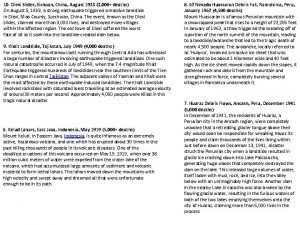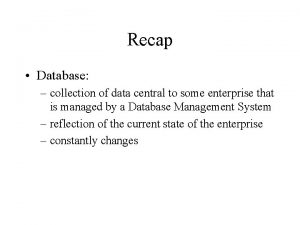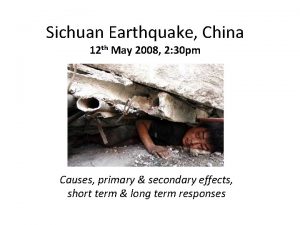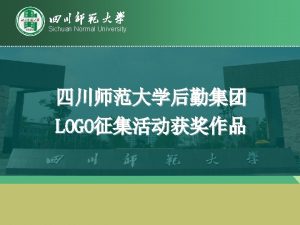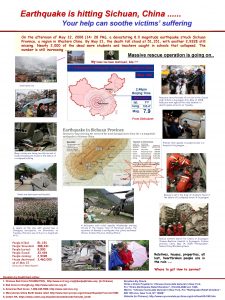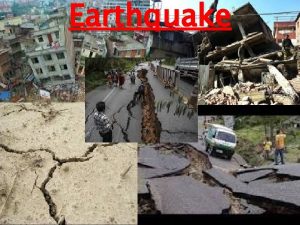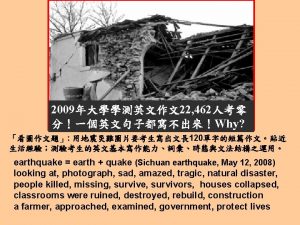RECAP CASE STUDY SICHUAN CHINA EARTHQUAKE 2008 CASE












- Slides: 12


RECAP: CASE STUDY SICHUAN CHINA EARTHQUAKE 2008

CASE STUDY SICHUAN CHINA EARTHQUAKE 2008 • • When? May 12 th 2008 Where? Sichuan- mountainous region of SW China Magnitude? 7. 8 How caused? The quake was caused by the collision of the Indian. Australian and Eurasian plates along the 155 -mile- (249 -km-) long Longmenshan Fault, a thrust fault in which the stresses produced by the northward-moving Indian-Australian plate shifted a portion of the Plateau of Tibet eastward.

Primary effects: Ground shaking and building collapse- 69, 000 people died…

Secondary effects: Deadly landslides….

Responses…

Sichuan Initial Response: Aid and relief • • 1, 500, 000 temporary homes built 4, 820, 000 garments 4, 820, 000 quilts 2, 460, 000 tonnes of coal 1, 430, 000 tents 1, 150, 000 tonnes of fuel oil $3, 370, 000 from China’s disaster relief fund

• Just 90 minutes after the earthquake, Premier Wen Jibao, who has an academic background in geomechanics, flew to the area to oversee rescue work • Immediately following the earthquake, 80, 000 troops sent • The remote mountainous areas received aid by air (soldiers parachuted and supplies dropped)

Long term management (1) • The Chinese government believed many areas were now too dangerous for people to live in. Programme of relocation for mountain communities is still continuing. • Priority - building ~ 4 million new homes, creating 1 million new jobs • Also to provide earthquake-proof buildings • A commitment that 3 million rural homeless families will get new homes and 860, 000 city apartments will be built

Long term management (2) • Government immediately committed £ 800 m to strengthening the 2600 schools that remained standing in Sichuan Province • Almost 4500 new primary schools to be built in Sichuan and neighbouring Gansu and Shaanxi province • 169 new hospitals • Total reconstruction bill will be US $150 billion

WHITEBOARD THINKING So, based on the information you have read about Sichuan, Chinese earthquake 2008, what management strategies would you say were in place? 1. Modify the event – ability to control, avoid, resist - involves engineering and technologies 2. Modify vulnerability/the risk – eg prediction, warning, preparedness, education 3. Modify the loss – eg aid; insurance cover WHAT IS YOUR DIRECT EVIDENCE FOR THIS?

MANAGING THE 2008 SICHUAN EARTHQUAKE: ‘MODIFYING THE EVENT’ • The overriding form of earthquake management in China has been that of ‘Modifying the event’ since the Chinese Government saw the 2008 earthquake as an opportunity to rebuild the area from scratch. • 2 years after the earthquake: • 1) 97% of the planned 299, 704 reconstruction projects in the region had started. • 2) 99% of the 196 , 000 farmhouses destroyed in the earthquake had been rebuilt. • 3)216 transport projects ( highways, main roads, railways and airports)were under construction or had been completed. • THESE EFFORTS HAVE NOT ONLY IMPROVED PEOPLES’ LIVES AND THE REGION’S ECONOMY , BUT THEY HAVE ALSO MADE THE AREA MORE RESILIENT TO FUTURE HAZARD EVENTS.
 Diexi slides
Diexi slides 2008 2008
2008 2008 The china danced on the shelves during the earthquake.
The china danced on the shelves during the earthquake. The water beckoned invitingly to the hot swimmers meaning
The water beckoned invitingly to the hot swimmers meaning China 1290 earthquake
China 1290 earthquake Project failure case study
Project failure case study Summary of shawshank redemption
Summary of shawshank redemption What first attracted gatsby to daisy chapter 8
What first attracted gatsby to daisy chapter 8 What is price matching
What is price matching What is the purpose of an iteration recap?
What is the purpose of an iteration recap? Recap intensity clipping
Recap intensity clipping 60 minutes recap
60 minutes recap Recap database
Recap database
